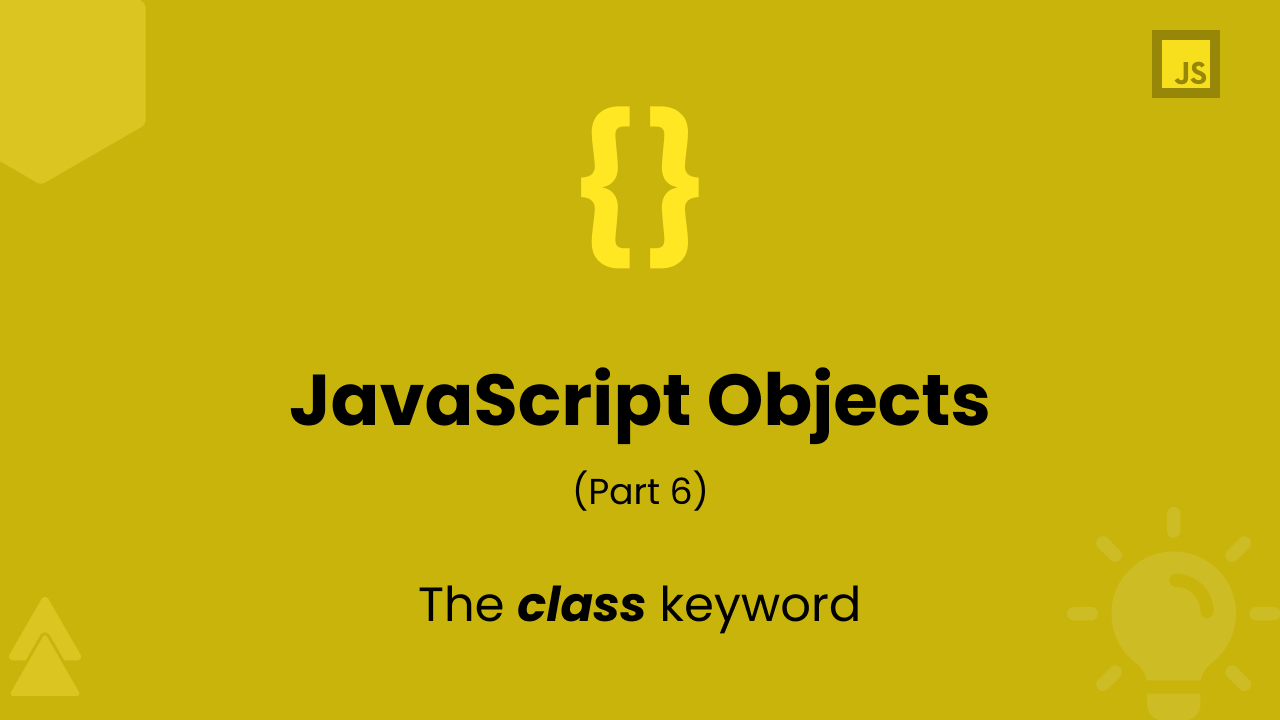Understanding JavaScript Objects (Part 6)
4 min read
Till now we saw various concepts related to objects in JavaScript, how they are implemented, how they work (sometimes in a weird way). This post is no different where we understand objects, this time with the help of the newly added class keyword. We'll see what the class keyword is and there is nothing like classes in JavaScript.
Using the class keyword
As many other languages, the way we create classes is pretty much the same. We use the class keyword and then give the class name and then use new keyword to create an object.
class Weapon {
constructor(damage) {
this.damage = damage;
}
hit() {
return this.damage;
}
}
const sword = new Weapon(33);
console.log(sword.hit()); // 33
Also, as other languages, JavaScript classes can also inherit from other classes.
class Weapon {
constructor(damage) {
this.damage = damage;
}
hit() {
return this.damage;
}
}
class Bow extends Weapon {
constructor() {
super(55);
}
}
const bow = new Bow();
console.log(bow.hit()); // 55
This is the behavior that we expect. But, as everyone knows, JavaScript is weird. Although JavaScript have classes, there is no way we can make the members private. Developers use an _ before the name (ex. _damage) to convey that the member should be considered as private. Still, anyone can access it and change it. There is no trick to make members private.
There is a TC39 proposal at Stage 3 at the time when I'm writing this blog which aims to add actual implementation of private methods and accessors (getter/setter) to the language itself.
Why JavaScript does not have the basic functionality that every other Object Oriented Programming language has? Because there are no classes in JavaScript. This is just an illusion. In one of the previous posts, we saw how the new keyword works. The new keyword can be used on the constructor functions to create object and fake the functionality of classes. The class keyword in the newest version of JavaScript (ES6) is no different. It's just another syntax for the developers that aren't familiar with JavaScript.
Here's the proof that there are no classes in JavaScript.
class Weapon {
constructor(damage) {
this.damage = damage;
}
hit() {
return this.damage;
}
}
console.log(typeof Weapon); // function
See? The Weapon class we just created is nothing but a function. The inheritance is also the prototypal inheritance that we've discussed earlier. This means that the hit method is present on the prototype of Weapon.
class Weapon {
constructor(damage) {
this.damage = damage;
}
hit() {
return this.damage;
}
}
const hit = Weapon.prototype.hit();
console.log(hit); // undefined
But, why do we get undefined? Because the damage property is undefined (You should have known that if you've read the previous posts).
Using our knowledge
We saw that the class keyword is just a syntactic sugar over the function constructors. This means that we can use the prototype property to access the methods or even add new methods. These methods are just normal functions on the prototype of the function constructor.
In the above example we get undefined as a result when we call the hit method. How do we overcome it? We just saw that these are just normal functions and normal function has access to the bind function that we saw in the first post. We can use it to bind that function to an object that has the damage property and it will log the expected result.
class Weapon {
constructor(damage) {
this.damage = damage;
}
hit() {
return this.damage;
}
}
const hit = Weapon.prototype.hit.bind({ damage: 20 })();
console.log(hit); // 20
Another thing we can do is.
class Weapon {
constructor(damage) {
this.damage = damage;
}
hit() {
return this.damage;
}
}
const sword = new Weapon(33);
console.log(Weapon.prototype.isPrototypeOf(sword)); // true
This proves that we just use prototypes.
This concludes this series on understanding the JavaScript objects. JavaScript can be weird language at times, but, if you know how it works, it's not that weird as you think.
Summary
- There is nothing like
classin JavaScript. - The
classkeyword is just a syntactic sugar over function constructors. - Inheritance is achieved through prototypal inheritance (as in the Function constructors).
Note: This series is heavily inspired by Fun Fun Function's series on Object creation. The series may give you more insights as it has live coding examples.

